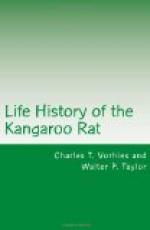Eleven species represented. First instance of quantity storage of Aplopappus gracilis. First occurrence of Loeflingia pusilla and Astragalus nuttallianus.
DEN 24.
November 8, 1921. On mesa northeast of Albuquerque, N. Mex., near base of Sandia Mountains. Fair grass growth here during preceding summer.
Species stored. Grams.
Sporobolus cryptandrus strictus
5,455
Salsola pestifer
295
-----
Total
5,750
Two species represented. The heads of Sporobolus cryptandrus strictus are retained to a great extent within the leaf sheaths. This necessitates the cutting of the stems into suitable lengths for carrying, and the stored material appears to be merely cut sections of the stems. Close examination, however, discloses the heads within, and shows that as in other instances seed storage is the end sought. These pieces are packed beautifully parallel like so many matches, and vary from a minimum length of 20 to a maximum of 37 millimeters, averaging about 30. Count of 2 grams of the above Sporobolus material shows that there are 125 separate cut sections per gram, or a total of approximately 680,000 pieces in this one lot of storage, indicating a remarkable activity on the part of the individual rat (Pl. VIII, Fig. 1).
[Illustration: PLATE VII. FIG. 1.—DEN EXCAVATED ON RANGE RESERVE.
Vertical section through Den No. 1, of Table 1 (p. 20), showing the complex system of burrows, some of them plugged with closely packed storage (outlined in white), the depth of the den, and the widened chambers centrally located.]
[Illustration: PLATE VII. FIG. 2.—CONTENT OF EXCAVATED DEN.
Storage content of Den No. 1 (Fig. 1, above), showing the separate species of plants listed in Table 1. The rod is 1 meter long. The large pile on the left is composed of seed-laden heads of crowfoot grama (Bouteloua rothrockii), the large pile on the right consists of heads of six-weeks grama (Bouteloua aristidoides), the pile of heads in the center is desert plantain (Plantago ignota), and the smallest heap is composed of buckwheat-bush seeds (Eriogonum polycladon).]
The number of lots of storage (24) studied in detail, extending as it does over a period of three years with seasons of varying growth conditions, is not sufficient to permit the construction of a curve showing increase and decrease in quantity of stored material with growing seasons and intervals between; but the results indicate a very decided increase during the autumn storing season, and continuing large well into the winter, since some outside material can still be obtained until midwinter. From about February to April a decrease may be noted, followed, if the spring growth of annuals be good, by a slight increase; and we can very nearly predict the general character of the increases and decreases by the precipitation and consequent growth conditions.




